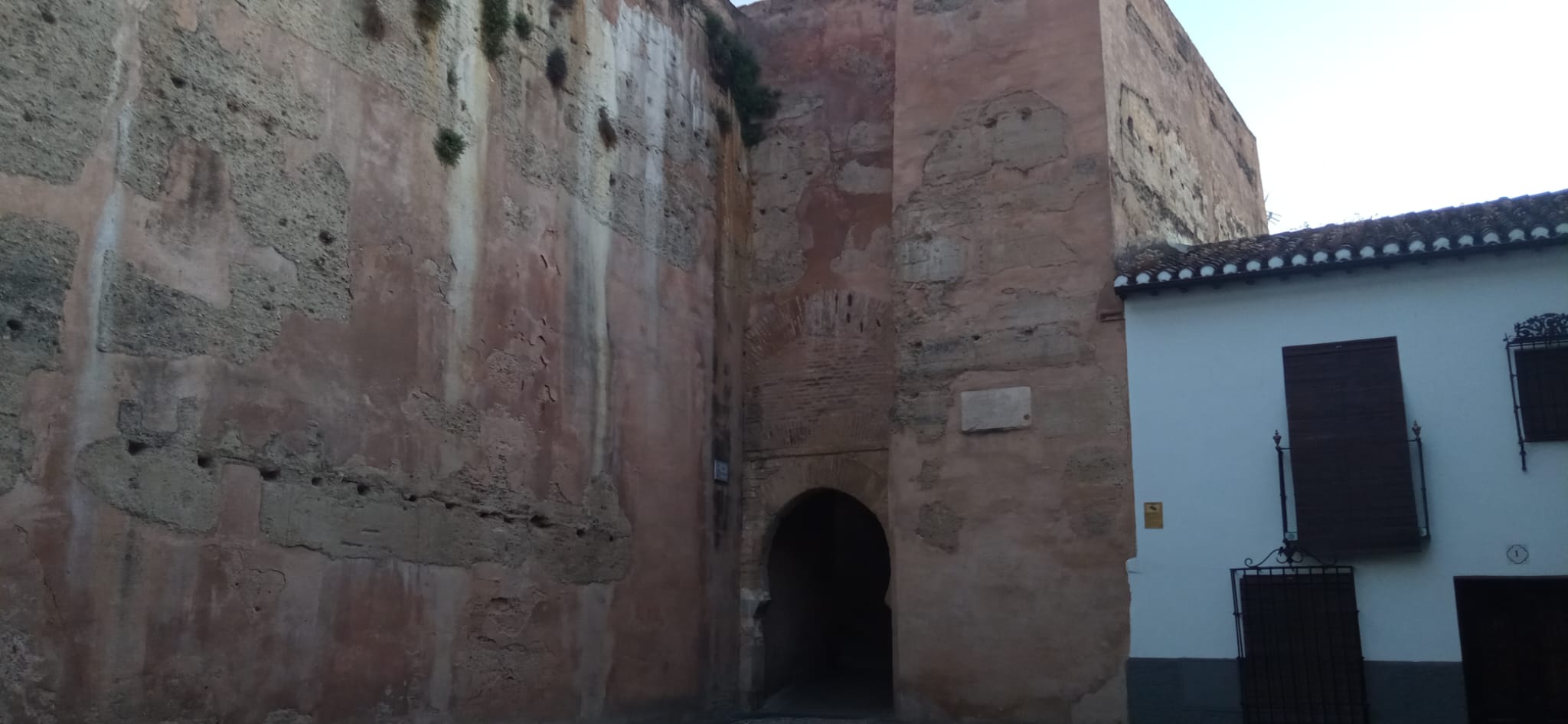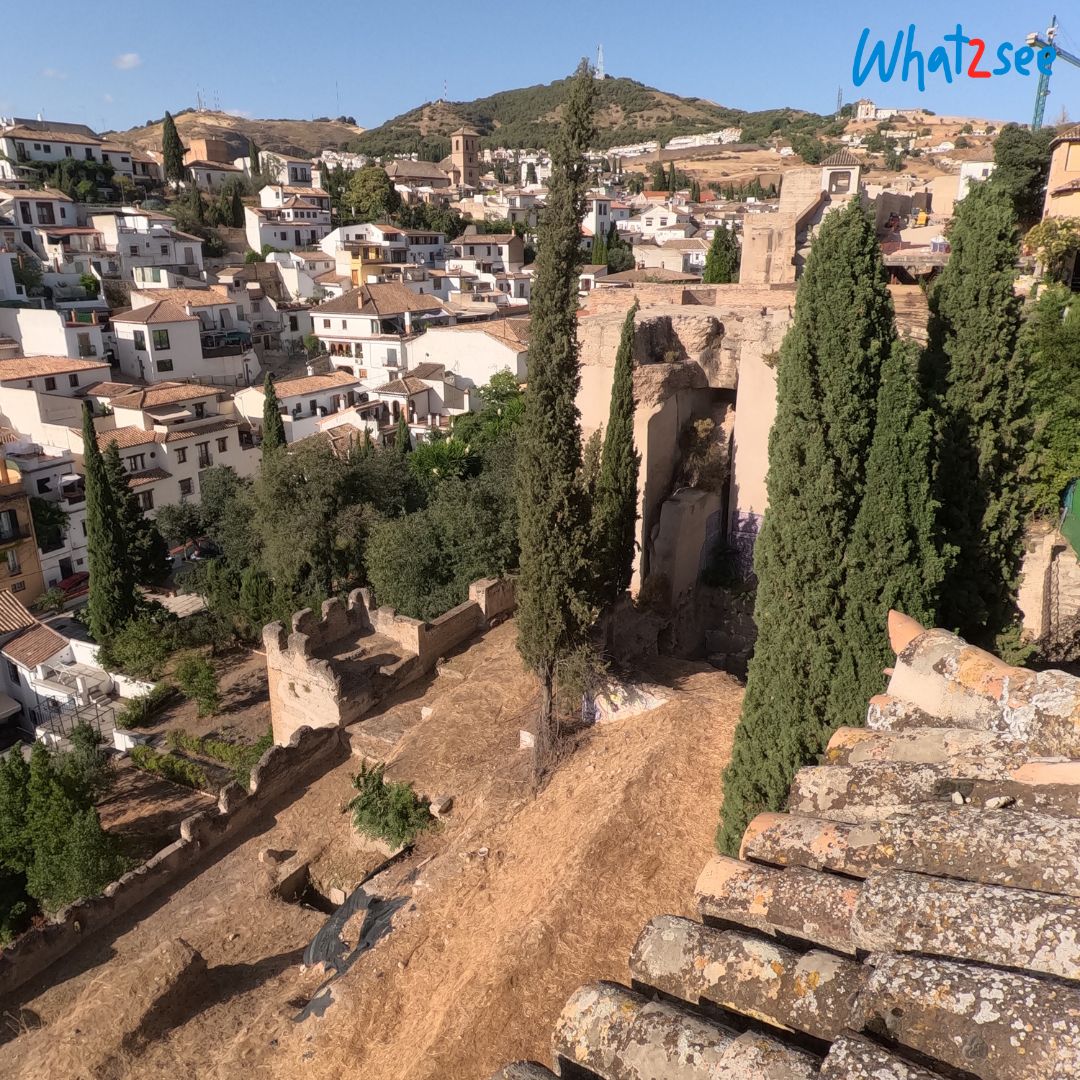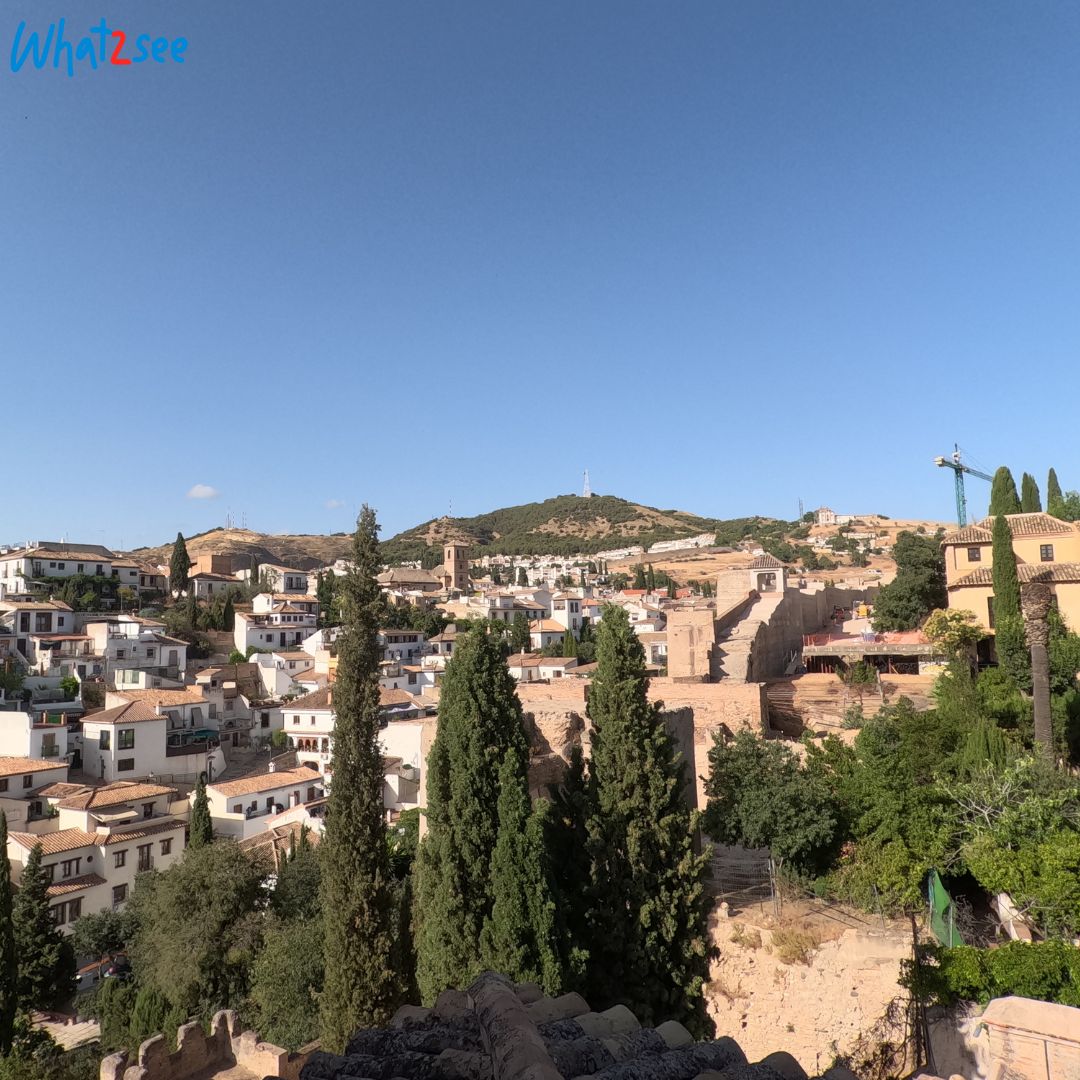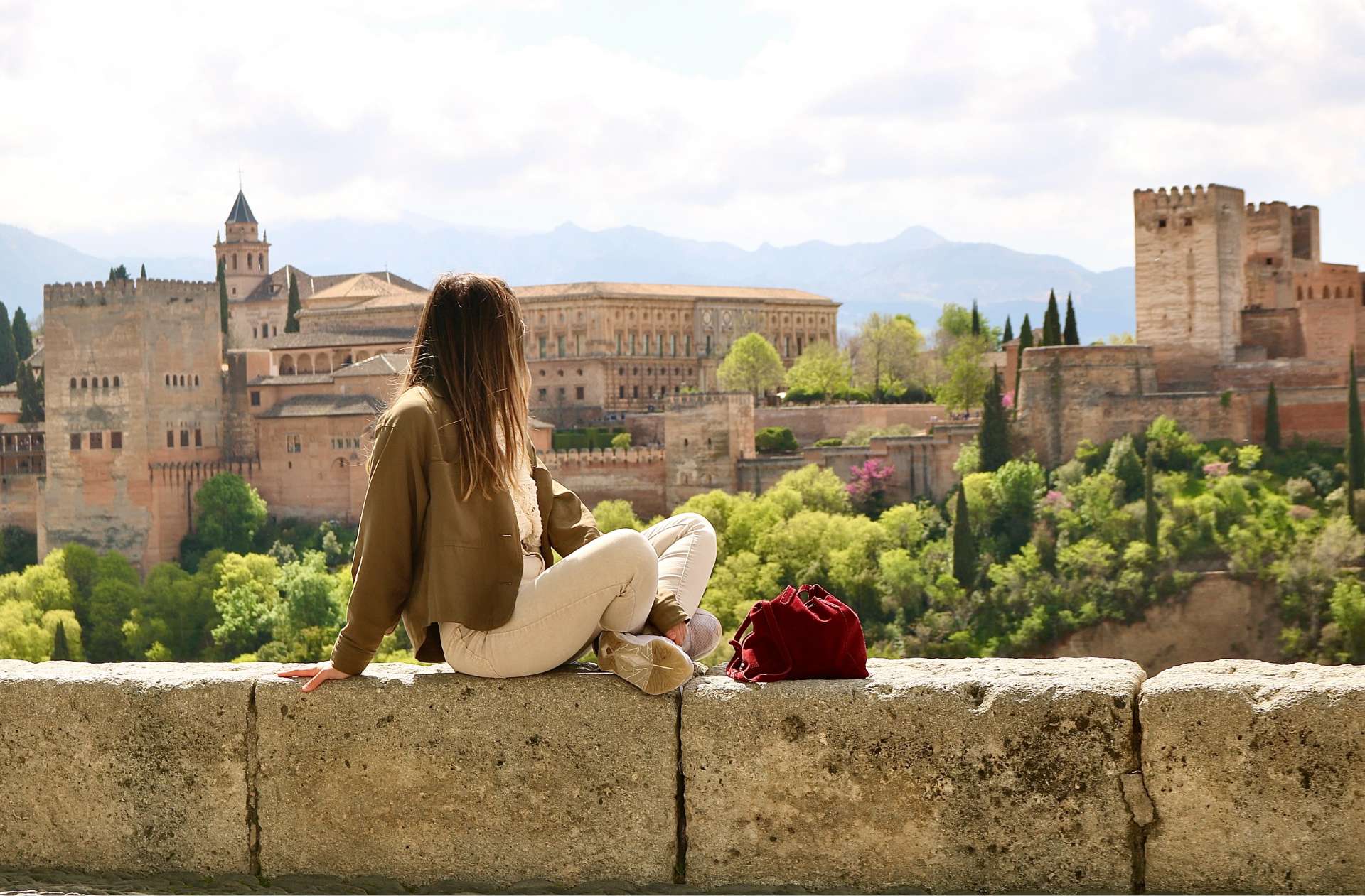Albaicín Wall: A Journey into Granada’s Defensive Past
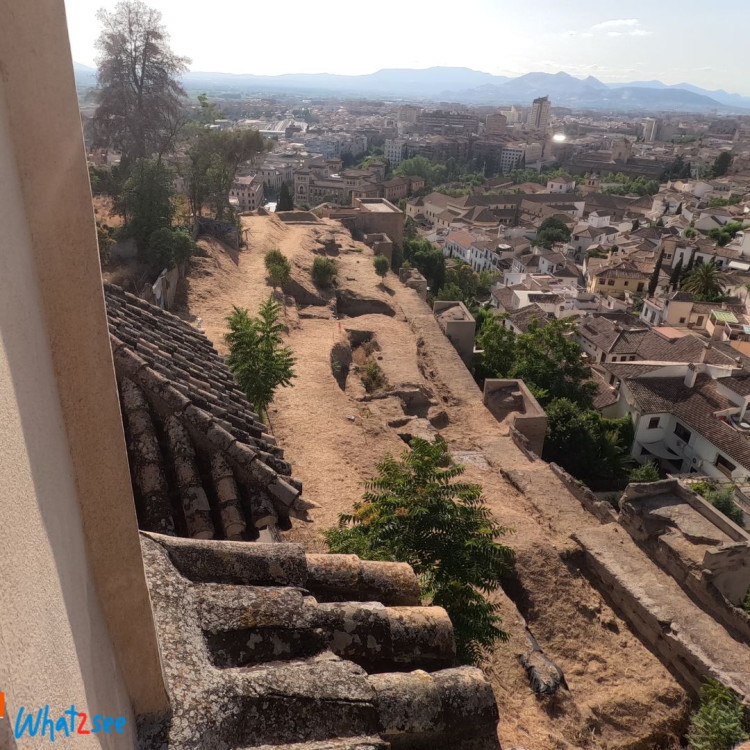
Today, we invite you to travel back in time along its defensive backbone: the Wall of the Albaicín
Welcome to the Albaicín, the Granada neighborhood that holds more stories than a grandpa at a family dinner! Today, we invite you to travel back in time along its defensive backbone: the Wall of the Albaicín, a fortification that not only protected the city, but still whispers its secrets if you listen closely.
Put on comfy shoes (and your best dreaming mood), because we're about to start a walk that blends history, legend, and views that’ll take your breath away — and not just because of the hills.
Its walls of stone and rammed earth snake across the hillside where this historic neighborhood rests. This fortification system, declared a World Heritage Site by UNESCO along with the rest of the Albaicín, lets us connect with centuries of history through its towers, gates, and preserved sections.
How to Reach the Albaicín Wall
First things first: the Albaicín Wall is not a straight line — it’s a living presence woven between whitewashed houses, squares, viewpoints, and alleyways that feel straight out of a Moorish novel. And that’s exactly where its magic lies.
Easy option: The bus that flies you up the hill
If you’d rather not arrive sweating like Boabdil in his final battle, take a microbus. Lines C31, C32, and C34 are small, nimble, and even charming. They take you straight from downtown Granada into the heart of the Albaicín.
Hop off at:
Plaza Larga – Key stop to see the Arch of the Weights and soak up local vibes with olives and flamenco in the background.
San Cristóbal – Includes a viewpoint and sections of wall peeking through the cypresses.
Carretera de Murcia – A higher entry point with great views and fewer crowds.
Brave option: Hike from the city center
If cardio-tourism is your thing, start climbing from Plaza Nueva. You've got two scenic routes vying for the “most beautiful” title:
Via Carrera del Darro and Cuesta del Chapiz – Probably the most photogenic street in Spain. Watch your step, though — more tourists have stumbled here than along the entire Via Dolorosa.
Circular Route: The Full Experience
Want a magical ring-shaped tour? Here's the What2see proposal to see the full wall without missing a thing:
Start at Puerta de Elvira – The old Islamic city’s main entrance. You can still feel that solemn “you’re entering Granada” vibe.
Climb the Cuesta de la Alhacaba, where the Zirid walls rise like ancient sentinels. This stretch is pure epic — double walls, towers, and legends in every meter.
Reach Puerta Monaita, maybe the most strategic and defensive gate. Close your eyes and you might hear the sound of hooves.
Descend toward Plaza Larga to meet the Arch of the Weights (once a customs checkpoint) and dive into neighborhood life: fruit stalls, locals arguing about football, kids chasing cats.
Continue to Puerta de Fajalauza, the most artisanal gate. Potters passed through here — and rumor has it, a few spies too.
Recommendations for Dreamy Walkers
Comfy shoes or you’ll die on the hills (figuratively, of course).
Water and sunscreen in spring or summer — the wall gives no shade, but plenty of heat.
Watch the slopes: some are steeper than a rollercoaster.
Bring a camera or a phone with free space: you’ll want to snap pics at every turn.
The Story of Granada’s Gates
Today, we pass through them without a second glance—between Instagram photos, takeaway coffees, and the occasional debate about where to have dinner. But a thousand years ago, the gates of the Albaicín wall were a whole different story: customs checkpoints, watchtowers, symbols of power... and sometimes even stages for betrayal, legend, and grand theatrical entrances.
Want to cross them again with us?
Monaita Gate (Bab al-Unaydar): The Fortress-Shaped Gate
Forget flat castle gates like in Playmobil sets. The Monaita Gate, built in the 11th century by the Zirids, was a full-on trap for invaders.
It had a bent entrance (no straight corridors), two opposing horseshoe arches, and a zigzag ramp designed to confuse even the bravest warrior. The enemy would walk in, get lost, and just as they were wondering why there were so many corners… bam! Surprise attack from above.
Declared a National Historic-Artistic Monument in 1931, this gate is a jewel of medieval defensive engineering. And yes, you can still walk through it. If you listen closely, you might hear the footsteps of Zirid guards.
Gate of the Weights (Bab al-Ziyad): The Market Gate
In Plaza Larga—where today you catch the scent of jasmine, Spanish omelette, and fresh bread—stands the Gate of the Weights, also known as the Arch of the Weights. This was the checkpoint for goods entering the Albaicín. And we’re not talking about a couple of boxes of figs. Entire caravans loaded with spices, fabrics, ceramics, and livestock were taxed here.
And the “weights”? The original stone ones are still embedded at the top of the arch as a public punishment — taken from merchants who cheated on their scales. A subtle Nasrid-style warning: “No funny business here, my friend.”
This gate separated two worlds: the Alcazaba Qadima (the old city) and the younger, more open and diverse Albaicín district. You can still feel that contrast today.
Fajalauza Gate: The Secret of the Potters (and Boabdil)
Among ceramics and legends rises the Fajalauza Gate, which has connected the Albaicín to the northern neighborhoods for centuries — especially to the kilns and workshops of Granada’s potters. Even today, "Fajalauza" is synonymous with soulful, handmade local ceramics.
But watch out — this gate also witnessed royal intrigue: in 1486, Boabdil entered through here incognito, wearing his best “nothing to see here” face, during Granada’s civil war. What looked like a discreet entrance turned out to be a bold political move that would mark the beginning of the end for the Nasrid kingdom.
What2see tip: Stop here and breathe in the neighborhood. Yes, literally. Everything smells like earth, like slow-cooked history. Visit the legendary Fajalauza factory nearby and take home a piece of Granada made by the finest hands.
Postigo de San Lorenzo: The Little Gate with Big Personality
Discovered almost by accident in 1983, the Postigo de San Lorenzo is like that side character in a movie who totally steals your heart. It’s small, hidden, and has all the charm of a secret door from a fantasy novel.
Its construction style is unlike any other gate in Granada.
It might have been used as a service entrance or an escape route… for lovers? Conspirators? Cats? Who knows. But there it is — discreet yet proud — guarding its mystery within centuries-old walls.
So, what do these gates tell us today?
At What2see Granada, we don’t believe gates are just for passing through. They’re meant to be crossed with intention.
Each one of these gates offers a different way to enter the city — and its story. Over the centuries, they’ve witnessed:
The footsteps of the first Muslim merchants
The clatter of horses on nighttime patrol
The laughter of children playing hide-and-seek in the maze of the Albaicín
And now… your footsteps, your camera, and your curiosity to discover
The Evolution of Granada’s Walls
From Iliberri to the Alcazaba Qadima: The First Steps
Before Granada was known by its current name, there was Iliberri — an Iberian settlement later Romanized as Municipium Florentinum Iliberitanum. This early nucleus was located on the Albaicín hill, where the Alcazaba Qadima would later be built. During the Zirid period in the 11th century, this site became the defensive heart of the city.
The Zirid Era: Rammed-Earth Fortresses and Watchtowers
With the founding of the Kingdom of Granada in 1013, the Zirids constructed a planned defensive system. The Alcazaba Qadima was surrounded by powerful tapial de argamasa (rammed earth and mortar) walls, punctuated by square and semicircular towers that guarded the roads and protected the inhabitants.
The Nasrid Splendor: Expansion and Refinement
Between the 13th and 15th centuries, under the reign of Yusuf I (1333–1354), the walls were expanded to include new suburbs. The Muralla Alberzana was built to defend the Rabad al-Bayyazin (Suburb of the Falconers). Construction techniques evolved into the more advanced tapial calicastrado, with a lime-based coating that made the walls more resilient and durable.
The Christian Conquest and Urban Transformation
After the Christian conquest in 1492, the defensive function of the walls diminished. Many sections were partially demolished or incorporated into new buildings. The gates were modified with Renaissance or Baroque elements, reflecting the cultural and architectural changes of the time.
Modern Restorations: Preserving Heritage
Today, several initiatives are underway to restore and conserve Granada’s walls. The Plan Alhambra, for example, includes the recovery of the Zirid Wall and its adjacent walkway, with an initial investment of €3.4 million. This project aims not only to restore the structures but also to create a public space that allows visitors and residents to connect with the city's history.
Architectural Features and Construction Techniques
When we walk alongside the Albaicín wall, we’re not just strolling through centuries of history—we’re walking next to a true masterpiece of traditional engineering! These walls weren’t thrown up over a weekend. Behind every stone, every hole in the surface, and every hidden corner lies a construction technique that combines ancestral knowledge with pure defensive logic.
Rammed Earth: The Soul of the Wall
The star of the show was rammed earth, a millennia-old technique where soil was compacted between two wooden molds. And not just any soil! Depending on the period and the budget (yes, even sultans had to keep an eye on expenses), several versions were used:
Basic rammed earth: the fastest and simplest method—kind of like the “express” version of the time.
Mortared rammed earth: with added lime for more strength and cohesion.
Lime-finished rammed earth (tapial calicastrado): the Ferrari of rammed earth, featuring a lime-rich outer layer that protected against water and gave a more elegant, durable finish—very typical of the Nasrid period.
Putlog Holes (Mechinales): Holes with a Story
You’ve probably noticed rows of holes in the wall and wondered, “What are those for?” No, they’re not bird nests or bullet marks. These are mechinales—the holes where wooden beams were inserted to hold the rammed-earth molds in place. Think of them as the temporary skeleton that made the whole process possible. Today, they’re silent witnesses of ancient craftsmanship… and perfect for snapping a photo during one of our history-packed walks!
Stone, Brick, and Expert Details
Besides rammed earth, other materials and techniques added strength and beauty to the construction:
Stone masonry in the foundations, to withstand centuries—and the odd earthquake.
Sandstone blocks at the corners and key structural points, to keep the whole thing from toppling down.
Brick in arches, vaults, and decorative touches, creating a visually rich and functional mix.
Real Defense: Towers, Gates, and More
This wasn’t just about building pretty walls—the design was purely strategic:
Towers of all shapes: square, semicircular, and rectangular, each covering a different angle of attack.
Gates with clever entrances: some were straight, others turned at angles like a maze, and some had ramps or tricky curves.
Parapet walks (adarves) for patrolling soldiers, battlements (almenas) like the ones we all know from the movies, and corachas—narrow walled passages leading to water sources like rivers or cisterns, ensuring safe access during sieges.
Did You Know…?
The Muralla de la Alhacaba, built by the Zirids, has such a peculiar design that it still baffles archaeologists: it has two parallel walls, separated by a space of around 10 meters! This layout created a defensive corridor, perfect for trapping any enemy who wandered in by mistake. Imagine soldiers waiting in silence between those walls... Definitely not for the claustrophobic.
So next time you look at a wall in Granada, don’t see “just an old wall.” See a story built out of rammed earth, strategy, and sheer ingenuity! And if you want to experience it with fresh eyes… you know What2see Granada is here to guide you—with passion, humor, and heart.
Ready to explore it with us?
Cultural and Historical Significance
The Albaicín Wall isn’t just an old structure—far from it. It’s the backbone of a neighborhood that breathes history in every corner, the echo of a past that still whispers through stones worn by time and by the footsteps of entire generations. It’s like a wise grandmother who, instead of telling you stories, shows them to you live and in full color.
Since the 11th century, this wall has seen it all: wars, secret romances, treaties between kingdoms, religious processions, curfews, smuggling… and today, guided walks with smartphones in hand and eyes wide with wonder. Every stretch you see holds a transformation: from Iberian settlement to Muslim Granada, then Christian, and now contemporary. It’s an open-air urban archive—with no glass cases, no labels.
The Wall That Drew the Neighborhood
You can’t understand the Albaicín without its wall. Its layout has shaped streets, corners, and even the very rhythm of life here. It’s that charming (and sometimes exasperating) labyrinth we’ve all wandered through—part admiration, part GPS frustration. Thanks to the wall, spaces like Plaza Larga, corners like Cuesta de la Alhacaba, and viewpoints like San Cristóbal came into being. Its presence still structures the neighborhood today.
More Than History: Identity, Art, and Emotion
For the people of Granada, the wall isn’t just a monument—it’s part of the soul. It’s that silhouette etched against the sunset with the Sierra Nevada in the background. It’s the image that artists, photographers, and poets have used again and again to speak of Granada without even naming it. Because the Albaicín Wall is Granada: multicultural, resilient, beautiful, and a little mysterious.
It’s also a powerful symbol of cultural dialogue—of time periods layered one over the other without erasing what came before. A place where an Arab horseshoe arch can coexist with a Baroque Virgin Mary or a piece of modern graffiti (that, hopefully, someone will clean up soon).
A History Lesson with a View
Today, the wall still teaches. Thousands of visitors walk it each year and discover, step by step, that there’s no better classroom than a thousand-year-old stone, and no better teacher than a city that’s willing to tell its story. It’s a top-tier educational resource—perfect for teaching history, urban planning, art, conflict, architecture, and above all, the importance of preserving what makes us unique.
Because yes—preserving this wall is a shared responsibility: of institutions, locals, visitors, and all those who love Granada. It’s a challenge, but also a golden opportunity to commit to a kind of tourism that’s sustainable, respectful, and full of meaning.
And since you’ve made it this far, we have just one question for you:
Want to walk it with us and hear the stories still whispered by every stone?
Spoiler: there are secrets, magical viewpoints, and a few anecdotes you won’t find in any book.
With love,
The What2see Granada Team
Cultural tourism with soul… and comfy shoes.

